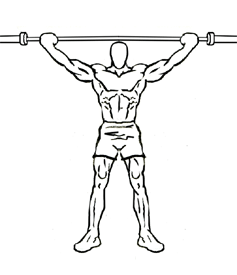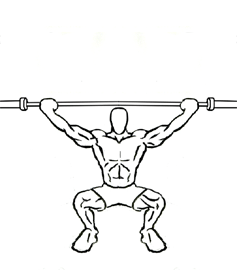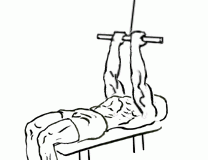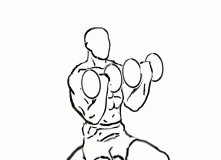Last Updated on November 7, 2024
The Overhead Squat with Barbell is a challenging, full-body exercise that not only builds leg and core strength but also improves mobility, balance, and stability. This advanced variation of the squat is almost the same as the Olympic Snatch lift. It demands proper form and precision, as you need to hold a barbell overhead while executing a deep squat. Although it requires significant coordination and practice, the Overhead Squat is incredibly rewarding for athletes, powerlifters, and anyone aiming to build functional fitness.
In this guide, we’ll cover the anatomy of the muscles involved, step-by-step instructions for perfect form, tips for effective execution, and advanced variations to make the most out of the Overhead Squat. Whether you’re new to this exercise or looking to refine your technique, this guide will help you build strength and stability with the Overhead Squat.
Why the Overhead Squat with Barbell?
The Overhead Squat is much more than just a lower-body exercise. It targets several key muscle groups, enhances mobility, and builds functional strength for daily activities and athletic performance. Here are some primary benefits:
- Total Body Strength: Holding a barbell overhead while squatting activates muscles from your shoulders to your calves, making it a fantastic total-body movement.
- Core Stability: The Overhead Squat is one of the most effective exercises for engaging the core, which helps stabilize your torso and protect your spine.
- Improved Mobility: Performing a squat with the arms overhead requires mobility in the hips, ankles, shoulders, and thoracic spine, making this exercise excellent for improving overall flexibility and range of motion.
- Enhanced Coordination and Balance: Keeping the barbell overhead challenges your balance and coordination, helping develop body awareness and proprioception.
- Functional Strength: The Overhead Squat is often used in sports training as it mimics movements where both upper and lower body strength are needed simultaneously, like lifting and carrying.
Muscles Worked in the Overhead Squat
The Overhead Squat primarily targets the following muscle groups:
- Quadriceps: The quads, located at the front of the thighs, are responsible for knee extension and play a significant role in the squatting movement.
- Glutes: The gluteus maximus is heavily involved in hip extension, powering the upward motion of the squat.
- Hamstrings: Positioned at the back of the thighs, the hamstrings assist with hip extension and help stabilize the lower body.
- Core Muscles: The Overhead Squat requires significant engagement of the core muscles, including the abdominals and obliques, for stabilization.
- Shoulders and Traps: Holding the barbell overhead requires shoulder stability and traps engagement, keeping the bar secure throughout the movement.
- Upper Back: The rhomboids and upper back muscles help maintain proper posture, supporting the weight overhead.
By activating both the upper and lower body, the Overhead Squat builds balanced strength and functional power.
Step-by-Step Guide: How to Perform the Overhead Squat with Barbell
Equipment Needed: An Olympic barbell, possibly with added weight plates if you’re more advanced.
1. Setting Up
- Grasp the Bar: Use a wide snatch grip on the barbell. Your hands should be positioned wider than shoulder-width apart to provide stability when holding the bar overhead.
- Stand in Position: With the barbell positioned on a rack or lifted overhead, stand with your feet slightly wider than shoulder-width apart and your toes pointed slightly outward.
2. Starting Position
- Lift the Bar Overhead: Press the bar overhead with your arms fully extended, ensuring it aligns with the back of your head and is positioned slightly behind your ears. Keep your elbows locked and wrists aligned with your forearms.
- Engage Your Core: Draw in your abs and keep your back tight, focusing on maintaining a neutral spine.
- Fix Your Gaze Forward: Looking slightly upward helps keep the chest lifted, which is crucial for balance and stability in the squat.
3. Execution
- Initiate the Squat: Begin by bending your knees and hips simultaneously, lowering your body while keeping the barbell directly overhead.
- Maintain Alignment: As you descend, push your hips back and keep your chest up, ensuring the barbell stays in line with your heels for optimal stability.
- Lower to Parallel: Aim to lower your body until your thighs are parallel to the floor. Ensure your knees are tracking over your toes without caving inward.
4. Return to Starting Position
- Drive Through Your Heels: Push through your heels to rise back up, straightening your knees and hips while keeping the barbell stable overhead.
- Maintain Control: Keep your core tight and chest lifted as you return to a standing position.
- Repeat: Perform 6-10 repetitions for 3-4 sets, depending on your fitness level and goals.
Tips for Perfecting the Overhead Squat with Barbell
- Use a Snatch Grip: The wider grip offers more stability when holding the barbell overhead, reducing the strain on your shoulders and enabling better control.
- Focus on Mobility: If you’re struggling with depth or form, work on mobility exercises for the ankles, hips, shoulders, and thoracic spine to improve your range of motion.
- Keep the Bar Aligned with Your Heels: For balance, ensure the barbell stays over your heels rather than shifting forward. This helps prevent falling forward and keeps the movement stable.
- Engage the Core Throughout: Maintaining a tight core is essential for spine support and overall stability. Think of bracing your midsection as if preparing for a light punch.
- Start with an Empty Bar: Master the form and balance of the Overhead Squat with an empty barbell before adding weight.
Common Mistakes to Avoid
Avoiding these common mistakes can help you perform the Overhead Squat effectively and safely:
- Letting the Bar Drift Forward: This shifts the load away from your center of gravity, putting unnecessary stress on your shoulders and lower back.
- Caving Knees: Ensure your knees track in line with your toes to avoid straining the knee joints. Focus on pushing your knees outward as you squat.
- Arching the Lower Back: Hyperextending the lower back can lead to injury. Engage your core to maintain a neutral spine and prevent over-arching.
- Not Reaching Full Depth: Shallow squats limit muscle engagement and reduce the benefits of the exercise. Aim for thighs parallel to the floor or lower.
- Using Excessive Weight Too Soon: Start with a manageable weight, focusing on mastering form before increasing the load.
Benefits of the Overhead Squat with Barbell
The Overhead Squat offers numerous benefits that extend beyond simple strength gains:
- Strengthens the Entire Body: The Overhead Squat engages multiple muscle groups, promoting balanced development and enhancing full-body strength.
- Increases Mobility and Flexibility: Squatting with the bar overhead improves flexibility in the shoulders, hips, ankles, and upper back.
- Develops Core Stability: The core must remain engaged throughout the movement, providing a significant challenge to abdominal and lower back muscles.
- Builds Shoulder Stability: Holding the barbell overhead strengthens the stabilizer muscles around the shoulder joint, improving overhead lifting capacity.
- Improves Balance and Coordination: The complex movement pattern enhances body awareness and balance, which can benefit other exercises and daily activities.
Variations of the Overhead Squat with Barbell
Incorporating variations can help target different aspects of the Overhead Squat, making your workout routine more effective and engaging:
- Dumbbell Overhead Squat:
- Use dumbbells instead of a barbell, holding one in each hand with arms extended overhead. This variation allows for independent arm movement, helping address imbalances and providing additional stability challenges.
- Kettlebell Overhead Squat:
- Perform the squat with a single kettlebell overhead, which requires greater core engagement and stability. This variation is especially useful for building unilateral strength.
- Single-Arm Overhead Squat:
- Use one arm to hold the barbell or dumbbell overhead, adding a greater balance and stability challenge. This exercise is effective for improving shoulder strength and unilateral balance.
- Snatch-Grip Overhead Squat:
- Focus on a wider grip, similar to the Olympic snatch lift. This grip requires more flexibility in the shoulders and upper back and allows for heavier weights once mastered.
- Overhead Squat with a PVC Pipe or Broomstick:
- For beginners, using a PVC pipe or broomstick allows you to work on form and mobility without the added weight, helping you build the foundation for the movement.
Integrating the Overhead Squat into Your Workout Routine
The Overhead Squat is best incorporated into a full-body or lower-body strength routine. Here’s a sample workout to include it effectively:
- Warm-Up:
- Start with 5-10 minutes of light cardio followed by dynamic stretches for the shoulders, hips, and ankles.
- Sample Workout:
- Front Squats: 3 sets of 8-10 reps for overall leg strength.
- Overhead Squat with Barbell: 4 sets of 6-8 reps, focusing on form and stability.
- Romanian Deadlifts: 3 sets of 10 reps to target the hamstrings and glutes.
- Pull-Ups: 3 sets of 8-12 reps to build upper body strength and support shoulder stability.
- Plank: 3 sets of 1-minute holds to further engage the core.
- Cool-Down:
- End with static stretches, focusing on the shoulders, hips, quads, and hamstrings to aid recovery.
Adjustments for Different Fitness Levels
- Beginners:
- Start with a PVC pipe or an empty barbell, focusing on mastering the form and balance of the movement.
- Perform 2-3 sets of 8-10 reps with light resistance, gradually building up strength and mobility.
- Intermediate:
- Use a light to moderate barbell weight, focusing on achieving full depth and form. Aim for 3 sets of 8 reps with controlled movements.
- Advanced:
- Add weight to the barbell and incorporate variations like the snatch-grip Overhead Squat. Perform 4 sets of 6 reps, focusing on maintaining stability and balance.
Safety Considerations for the Overhead Squat
Safety is paramount with this advanced exercise. Here are some tips to avoid injuries:
- Warm-Up Properly: Engage in a full warm-up routine, including dynamic stretching, to prepare the body for this complex movement.
- Use a Spotter: If you’re lifting heavy, consider using a spotter or perform the exercise in a squat rack with safety bars.
- Start Light: Always begin with a lighter weight to ensure form and balance before progressing to heavier loads.
- Work on Mobility: Limited mobility in the shoulders, hips, or ankles can hinder your ability to perform the Overhead Squat correctly. Prioritize mobility exercises if you struggle with depth or positioning.
Final Thoughts on the Overhead Squat with Barbell
The Overhead Squat with Barbell is a rewarding yet challenging exercise that builds total-body strength, stability, and mobility. By focusing on perfect form, starting with a manageable weight, and progressing gradually, you’ll develop strong legs, a stable core, and improved shoulder stability. Adding this exercise to your routine can enhance your functional fitness, support other lifts, and improve overall athletic performance.planted on the floor throughout this exercise. Keep your abs drawn in your back tight and your chest up you perform this exercise.








